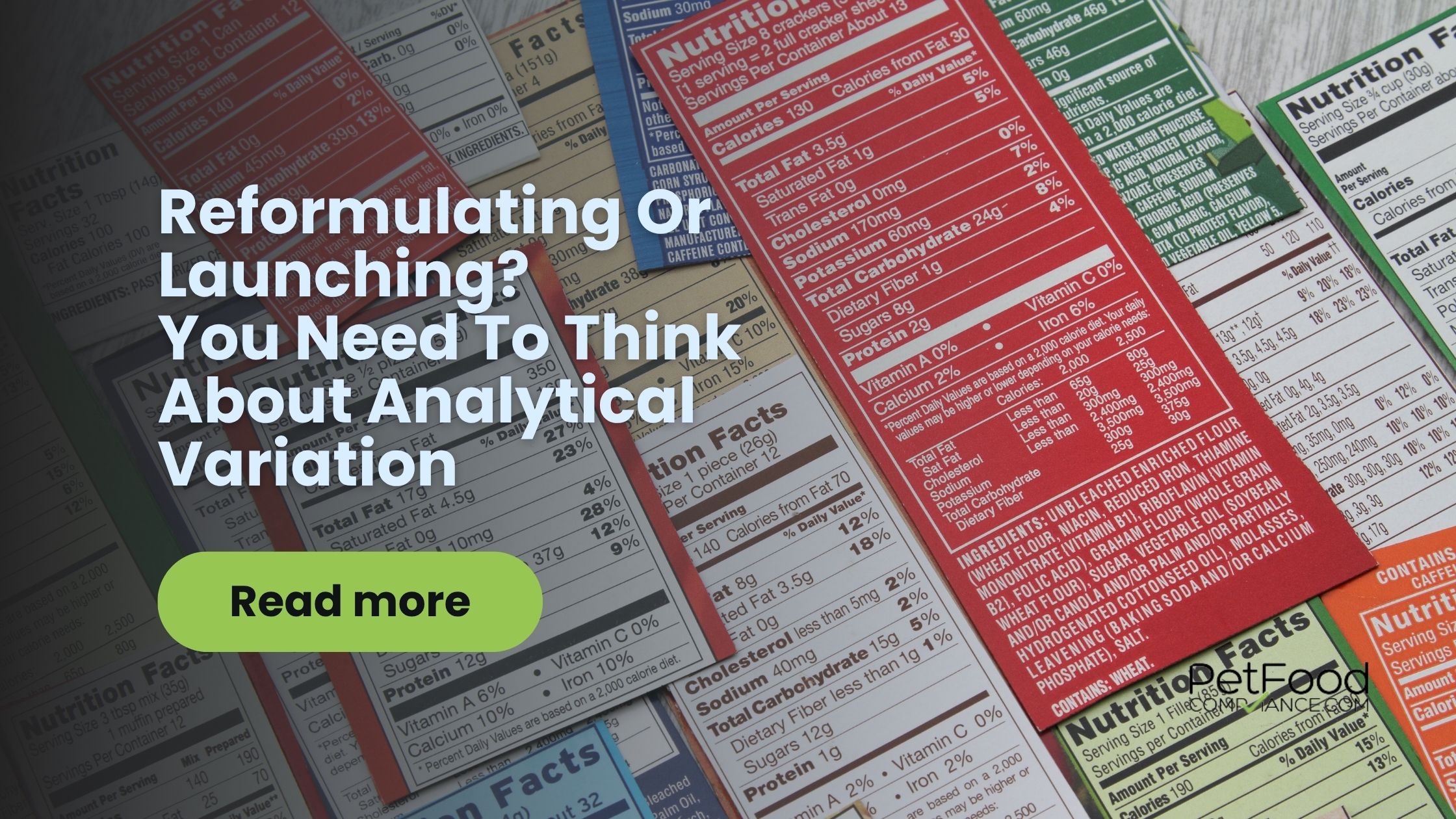To get access to the PAW platform or create an account or access please contact rc@petfoodcompliance.com.
Reformulating Or Launching? You Need To Think About Analytical Variation

While no pets were reported ill, the recall made headlines and rattled consumer confidence. Behind the scenes, the issue wasn’t just formulation—it was a disconnect between what was on the label and what was in the bag.
That’s where analytical variation comes in.
Most pet food founders know about guaranteed analysis (GA). But few realize that every nutrient on that panel is judged against strict—and sometimes outdated—AV limits. These determine how much wiggle room your product has when tested by a state lab.
A new study by the Texas Office of the State Chemist suggests that many of today’s AV limits don’t reflect modern lab data—and that means even fully compliant-feeling products could be at risk.
Let’s break it down.
What Is Analytical Variation?
AV, or analytical variation, refers to how much test results can vary from your label without triggering a compliance issue. It's there to account for:
- Differences in lab equipment
- Ingredient variability
- Batch-to-batch fluctuations
For example: your label says 10% fat. If the AV for fat is ±10%, that means regulators will accept test results between 9% and 11%.
But here’s the kicker: many AV limits haven’t been updated in decades. Until recently, no one could even locate the original data used to calculate them.
In a new analysis of AAFCO Check Sample data, Karen Fischer reviewed results from 2014–2017 to see if current AVs still match real-world lab variability. The conclusion?
A lot of them don’t.
Which Nutrients Are Most Likely To Trigger Compliance Issues?
Fischer’s team analyzed 53 datasets across key nutrients, calculating how often real test results fell outside of AAFCO’s official AV limits.
Here are the nutrients that raised the biggest red flags:
| Nutrient | % of Samples Above AV Limits |
| Vitamin A | 97.7% |
| Fiber | 79.6% |
| Selenium | 84.9% |
| Fat | 58.7% |
| Protein | 53.8% |
| Moisture | 78.8% |
That’s not “a few outliers.” That’s more than half of samples for multiple nutrients showing higher variation than AAFCO officially allows.
And while some ingredients—like magnesium or potassium—were solid, the most commonly claimed nutrients (fat, protein, fiber) were the ones most likely to fail.
If you’re working on a functional topper or a raw formula your risk of AV issues may be even higher.
How One Researcher Proposed A Smarter, More Realistic AV Formula
Recognizing the mismatch between real-world lab data and current AV limits, Fischer proposed a new way to calculate them: using tolerance intervals based on actual testing variability.
Unlike current flat AV formulas, these new models adjust depending on how much of a nutrient is in your product. Here’s what that looks like:
| Analyte | Current AV | Proposed AV Formula |
| Fat | 10% | 55.6 × e^(-0.054x) |
| Fiber | (30/x) + 6 | 50.9 × e^(-0.02x) |
| Protein | (20/x) + 2 | 4.6 × e^(-0.006x) |
| Selenium | 25% | 61.9 × e^(-0.002x) |
In plain English: a product with 25% protein has less allowable wiggle room than one with 10%—but that variation is based on data, not guesswork.
This is a big step forward for anyone trying to formulate cleanly and cost-effectively—especially if you’re already being pushed to overformulate just to stay inside AV.
But until AAFCO formally adopts these models, you’re still on the hook for meeting the current AV limits.
What This Means for Your Labels, Formulas, and Enforcement Risk
For most pet food companies, AV isn’t something you think about until a regulator flags your product—or worse, a retailer pulls it from shelves. But this study is a wake-up call to start thinking more strategically.
Here’s what we recommend:
✅ Recheck your guaranteed analysis
If your fat, fiber, or protein levels are close to the label numbers, they could be out of spec with just a minor test swing. A label audit can help you catch problems before regulators do.
✅ Review formulations after any changes
New supplier? Ingredient swap? Even a “minor” shift can bump nutrient levels out of compliance. Check your math—and your lab results—before the new version hits shelves.
✅ Pay special attention to high-risk nutrients
Start with fat, fiber, moisture, and protein. Then look at trace minerals like selenium and vitamins like A and B12, which showed wild variation in the study.
✅ Plan ahead for functional claims
If your product is marketed for joint health, digestion, or other functional benefits, you’ll want to be rock solid on nutrient levels and AV compliance. We can help you sort that out.
Don’t Let Old AV Rules Derail Your Next Launch
This AAFCO research offers one of the clearest signs yet that regulatory standards are due for a refresh. But until that happens, you’re operating under a system that may penalize even well-formulated products.
By getting proactive now—checking your GA levels, understanding your AV risks, and keeping up with emerging rules—you can avoid last-minute scrambles, stop-sale orders, and costly reformulations.
Need help interpreting your lab reports or assessing your risk? We can connect you with people who can help!
More Industry Updates
Join Our Newsletter
Good stuff only — we promise!


